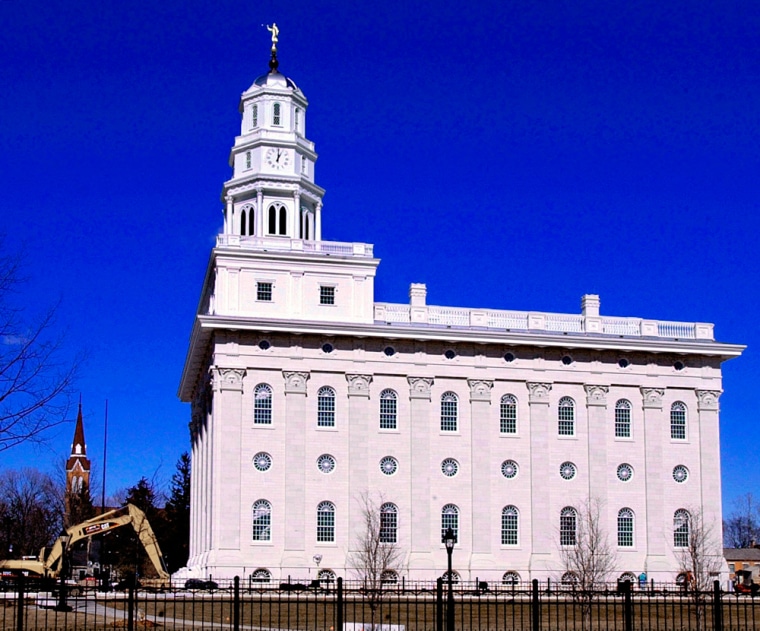Chandler Whipple recently logged his third 1,000-mile drive from Salt Lake City to this tiny, out-of-the-way town overlooking the Mississippi River, where history and faith have forged one of Illinois' hottest tourism draws.
Fellow Mormons Mark and Holly Gold also made the long drive from Utah to western Illinois recently to revisit ground they consider sacred, built by church founders who were chased west more than a century-and-a-half ago amid waves of violence.
"People see so many Utah plates here they probably think everyone from out there has to make a pilgrimage," joked Whipple. "They don't, but a lot do."
Up to 1.5 million visitors a year have flooded this town of just 1,100 people since 2002, when the Church of Jesus Christ of Latter-day Saints opened a towering, five-story temple that draws both Mormons and non-Mormons from around the world - some to gaze only at the outside, since only the most devout Mormons are allowed to enter.
The lavish temple, with a tower and spire 165 feet high, has fueled a fivefold tourism jump in Nauvoo, said Kim Farah, a church spokeswoman in Utah. Other attractions, including the home and grave of church founder Joseph Smith, drew only about 200,000 visitors a year before plans for the temple fanned interest in 1999.
Farah says Nauvoo's tourism jumped to about 1 million people a year after the temple was announced, then soared to 1.5 million when it opened in 2002, more than doubling first-year attendance three years later at Springfield's Abraham Lincoln Presidential Library and Museum.
Crowds thinned slightly after the opening-year rush, Farah said, but remains well above 900,000 visitors a year, pumping $22 million into the region's economy in 2005 alone.
"Economically, this area has seen some tough times. Tourism has become that saving grace for Nauvoo and Hancock County," said Rustin Lippincott, executive director of the Nauvoo Tourism Office.
Residents say fears have waned that the parade of tourists might forever disrupt their quiet little town above a bend of the Mississippi River, not far from Keokuk and Fort Madison, Iowa.
"It's good for (the) town; it's good for business," said Mary Fernetti, who has owned a needlework and souvenir shop in downtown Nauvoo since 1985.
David Miller, a downtown business owner and president of the Nauvoo Chamber of Commerce, agrees.
"When visitors slid a bit after the first couple of years, it made people feel like this wasn't going to be a town overrun. These people like their quiet, rural way of life," Miller said.
Officials estimate that about 70 percent of Nauvoo's visitors are Mormons, lured by deep and tragic roots in the town that church leaders founded in the 1830s after leaving New York, Ohio and Missouri.
As the frontier town grew, once nearly equaling Chicago with 15,000 residents, neighbors became distrustful of the new sect and leery of their increasing economic and political clout. Quarrels escalated to violence, ending with the shooting death of church founder Smith and forcing Mormons west in 1846, eventually to found Salt Lake City.
Their abandoned temple was desecrated by vandals, then gutted by an arson fire in 1848. A tornado later knocked down most of its walls, leaving little more than foundation stones until a church member's anonymous donation rebuilt the temple as a memorial.
That legacy draws thousands of Mormons to Nauvoo every year, sometimes in groups of 100 or more, along with busloads of non-Mormons lured by the area's rich history, which also includes Illinois' oldest winery.
"It exemplifies the spirit of the early pioneers and their sacrifice. You can feel their spirit in Nauvoo," Randy Marshall, a Mormon from Ogden, Utah, said this month while visiting the historic town with his wife and three children.
Worldwide, the 12.5 million member church has more than 100 temples, which are used for marriages, baptisms and other religious rites, but not worship services. Compared to the others, the remote Nauvoo temple serves a small population of nearby Mormons.
"This is really, you might say, a tourist temple. It's here because it's historically significant," said David Wright, who controls administrative duties as recorder for the Nauvoo temple
Temples are sacred and only about 30 percent of Mormons qualify to enter them, based on standards that include tithing, moral character and adhering to prohibitions on alcohol, tobacco and caffeine, Wright said.
Tourists can get a glimpse inside the temple through videos at a visitors center and don't complain about being kept outside, said Jon Larson, a Mormon missionary from Utah working as public affairs director for the church in Nauvoo.
Paula Mason, who frequently drives more than two hours from Peoria to visit Nauvoo, says just seeing the temple is enough.
"It's just a peaceful place where you can leave the world ... and you can't find that anywhere else," Mason, 67, said as she sat on a bench across the street from the temple entrance.
Officials say tourism sparked by the temple has added some lodging, restaurants and an arcade in Nauvoo, but not the business growth many expected.
Miller, president of Nauvoo's chamber for the last three years, says businesses are reluctant to build because church-related tourism peaks over the summer, then slows to a trickle.
He said expanding offseason tourism could pour another $10 million into the local economy, so officials are looking at options such as touting eagles that nest along the Mississippi River over the winter or the town's location within a few hours of Chicago, St. Louis and Kansas City.
"Anything that comes is going to be true to form with the history of Nauvoo," Miller said. "I still see it as a family-oriented town that has a rich history in all aspects of life."
